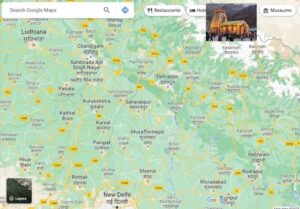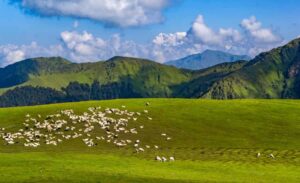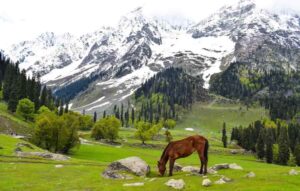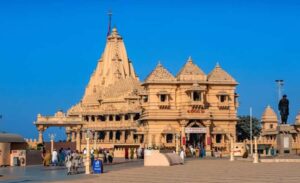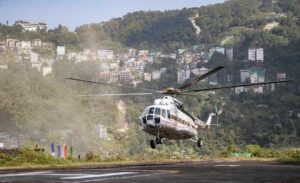The Ultimate Guide to the Kedarnath Trek
Nestled amidst the majestic peaks of the Garhwal Himalayas, the Kedarnath Trek stands as a testament to spiritual devotion and unparalleled natural beauty. Spanning across rugged terrains and breathtaking landscapes, this trek is not just a physical journey but a soul-stirring odyssey that connects pilgrims and adventurers alike with the divine essence of the Himalayan region. In this comprehensive guide, we delve deep into the intricacies of the Kedarnath Trek, providing a detailed roadmap, essential tips, and insights to ensure an enriching and fulfilling experience for all those who embark on this sacred pilgrimage.
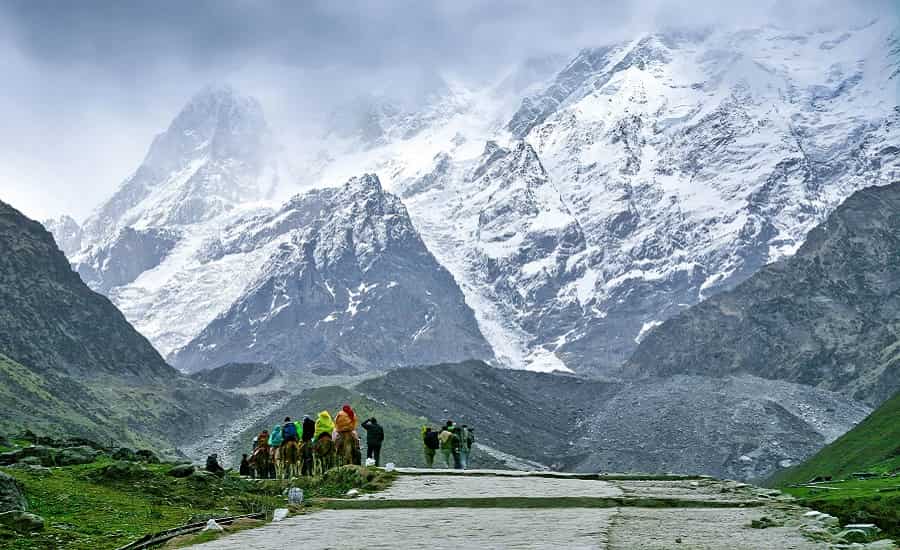
How to Reach Kedarnath by Road
Reaching Kedarnath by road involves a journey through the picturesque landscapes of Uttarakhand, navigating winding mountain roads and scenic valleys. The nearest town to Kedarnath is Gaurikund, which serves as the base camp for the trek to the temple. Here are the steps to reach Kedarnath by road:
- From Delhi: The most common starting point for travelers is Delhi, the capital city of India. From Delhi, you can embark on a road trip to reach Kedarnath.
- Route: The route from Delhi to Kedarnath typically involves driving through the following cities and towns: Delhi – Haridwar – Rishikesh – Devprayag – Srinagar – Rudraprayag – Agastmuni – Guptkashi – Sonprayag – Gaurikund.
- Distance: The total distance from Delhi to Gaurikund is approximately 450 kilometers, which takes around 14-16 hours by road, depending on traffic and road conditions.
- Transportation Options: Travelers can choose between self-driving, hiring a taxi, or using public transport like buses. Private taxis are readily available from Delhi, Haridwar, and Rishikesh for the entire journey or up to Gaurikund.
- Road Conditions: While most of the route is well-maintained, some stretches may be narrow and winding, particularly after Devprayag. It’s advisable to travel during daylight hours and exercise caution while driving.
- Parking Facilities: At Gaurikund, parking facilities are available for vehicles, where travelers can leave their cars or hire ponies and porters for the trek ahead.
Kedarnath Route from Delhi
The route from Delhi to Kedarnath offers breathtaking views of the Himalayas and passes through several towns and landmarks of cultural and historical significance. Here’s a detailed overview of the route:
- Delhi to Haridwar: The journey begins from Delhi, heading towards Haridwar, a sacred city on the banks of the Ganges River, known for its ghats and temples.
- Haridwar to Rishikesh: From Haridwar, travelers proceed to Rishikesh, the “Yoga Capital of the World,” famous for its ashrams, suspension bridges, and river rafting activities.
- Rishikesh to Devprayag: Continuing the journey, the route takes travelers to Devprayag, where the Alaknanda and Bhagirathi rivers converge to form the holy Ganges.
- Devprayag to Srinagar: Traveling further, the route passes through Srinagar, a picturesque town on the banks of the Alaknanda River, known for its scenic beauty and educational institutions.
- Srinagar to Rudraprayag: The journey then proceeds to Rudraprayag, a confluence of the Alaknanda and Mandakini rivers, offering panoramic views of the surrounding mountains.
- Rudraprayag to Agastmuni to Guptkashi: From Rudraprayag, travelers continue towards Agastmuni and Guptkashi, important stopovers en route to Kedarnath, where they can rest and refresh.
- Guptkashi to Sonprayag to Gaurikund: Finally, the route leads to Sonprayag and Gaurikund, the last motorable point before the trek to Kedarnath Temple begins.
- Gaurikund to Kedarnath Temple: From Gaurikund, pilgrims and trekkers commence their journey on foot, covering a distance of approximately 16 kilometers to reach the sacred Kedarnath Temple.
Kedarnath Trekking Distance
The trekking distance from Gaurikund to Kedarnath Temple is approximately 16 kilometers (10 miles) one way. The trail winds its way through steep ascents, rocky paths, and scenic landscapes, offering pilgrims a challenging yet rewarding experience. Depending on one’s pace and physical condition, the trek can take anywhere between 6 to 9 hours to complete.
Facilities at Kedarnath Trek
Despite its remote location, the Kedarnath Trek offers basic facilities and amenities to ensure the comfort and safety of pilgrims and trekkers. Here are some of the facilities available along the trekking route:
- Accommodation: Along the trekking route, pilgrims can find various accommodation options, including guesthouses, dharamshalas (pilgrim shelters), and tents. These facilities provide basic amenities such as beds, blankets, and meals for travelers.
- Food and Water: There are several tea stalls and small eateries along the trekking route, offering snacks, tea, and meals to pilgrims. It’s advisable to carry sufficient water and energy snacks to stay hydrated and energized during the trek.
- Medical Facilities: Basic medical facilities are available at several points along the trekking route, including first aid kits, emergency medical assistance, and access to oxygen cylinders for altitude sickness.
- Ponies and Porters: For travelers who may find the trek challenging, ponies and porters are available for hire at Gaurikund to carry luggage and provide assistance during the journey.
- Toilets: Temporary toilet facilities are set up at regular intervals along the trekking route for the convenience of pilgrims. It’s essential to maintain cleanliness and hygiene while using these facilities.
- Mobile Connectivity: While mobile network coverage may be limited or non-existent in certain areas, there are designated spots along the route where pilgrims can find network connectivity to make calls or access the internet.
- Security: Security personnel are deployed along the trekking route to ensure the safety and well-being of pilgrims. Travelers are advised to follow instructions and guidelines provided by authorities for a smooth and secure trekking experience.
Kedarnath Distance Chart from Major Cities
Here’s a distance chart indicating the approximate distance from major cities to Kedarnath:
- Delhi to Kedarnath: Approximately 450 kilometers
- Haridwar to Kedarnath: Approximately 240 kilometers
- Rishikesh to Kedarnath: Approximately 220 kilometers
- Dehradun to Kedarnath: Approximately 290 kilometers
- Gaurikund to Kedarnath Temple: Approximately 16 kilometers (trekking distance)
Kedarnath Trek Itinerary
A typical itinerary for the Kedarnath Trek involves the following stages:
Day 1: Arrival in Gaurikund
- Travel from Delhi to Gaurikund by road
- Check-in at accommodation in Gaurikund
- Rest and acclimatize for the trek ahead
Day 2: Trek from Gaurikund to Kedarnath
- Start early morning trek to Kedarnath Temple
- En route visit Rambara Bridge and other landmarks
- Reach Kedarnath by afternoon/evening
- Darshan at Kedarnath Temple
- Overnight stay in Kedarnath
Day 3: Return Trek from Kedarnath to Gaurikund
- Early morning darshan at Kedarnath Temple
- Start trek back to Gaurikund
- Rest and relax upon reaching Gaurikund
- Optional: Visit nearby attractions or continue journey
New Trekking Route for Kedarnath Dham
In recent years, efforts have been made to develop a new trekking route for Kedarnath Dham to improve accessibility and enhance the trekking experience. The new route, known as the Chopta-Kedarnath Trek, offers an alternative approach to reaching the sacred temple. Here are some key features of the new trekking route:
- Scenic Beauty: The Chopta-Kedarnath Trek passes through breathtaking landscapes, including lush forests, alpine meadows, and panoramic viewpoints, providing travelers with a memorable journey amidst natural splendor.
- Less Crowded: Compared to the traditional trekking route from Gaurikund, the Chopta-Kedarnath Trek is relatively less crowded, offering pilgrims a more serene and peaceful trekking experience.
- Shorter Distance: The new route is shorter in distance compared to the Gaurikund-Kedarnath route, making it ideal for travelers seeking a quicker and less strenuous trek to the temple.
- Facilities: Basic facilities such as accommodation, food stalls, and medical aid are available along the Chopta-Kedarnath Trek route, ensuring the comfort and safety of pilgrims and trekkers.
Challenges Faced During the Trek
While the Kedarnath Trek offers a spiritually enriching experience, it also presents several challenges that pilgrims and trekkers need to be aware of:
- Altitude: The trek involves ascending to high altitudes, with Kedarnath Temple located at an elevation of approximately 3,583 meters (11,755 feet). Altitude sickness can occur, especially for those not acclimatized to high altitudes.
- Weather Conditions: Weather in the Himalayas can be unpredictable, with sudden changes in temperature, rainfall, and snowfall. Trekkers should be prepared for varying weather conditions and carry appropriate clothing and gear.
- Physical Exertion: The trek involves walking long distances over challenging terrain, including steep ascents and descents. Trekkers need to be physically fit and prepared for the strenuous nature of the journey.
- Limited Facilities: While basic facilities are available along the trekking route, amenities may be limited, particularly in remote areas. Pilgrims should carry essential supplies such as water, snacks, and medicines to sustain themselves during the trek.
- Environmental Impact: The fragile ecosystem of the Himalayas is susceptible to environmental degradation due to increased tourism and trekking activities. Pilgrims should follow eco-friendly practices and minimize their environmental impact while trekking.
Trekking Tips & Things to Carry
To ensure a safe and enjoyable trekking experience to Kedarnath, here are some essential tips and things to carry:
- Fitness Preparation: Engage in regular exercise and physical activity to build stamina and endurance for the trek. Practice hiking on inclines and uneven terrain to simulate trekking conditions.
- Acclimatization: Spend a day or two in Gaurikund or nearby towns to acclimatize to the high altitude before starting the trek to Kedarnath Temple. Take it slow and allow your body to adjust to the altitude.
- Appropriate Clothing: Dress in layers to adapt to changing weather conditions. Carry warm clothing, including jackets, thermals, gloves, and hats, as temperatures can drop significantly at higher altitudes.
- Footwear: Wear sturdy and comfortable trekking shoes with good grip to navigate rocky terrain and uneven paths. Avoid wearing new shoes and break them in before the trek to prevent blisters and discomfort.
- Hydration and Nutrition: Stay hydrated by drinking plenty of water throughout the trek. Carry energy snacks such as nuts, dried fruits, chocolates, and energy bars to replenish energy levels during the trek.
- First Aid Kit: Pack a basic first aid kit containing essential medications, bandages, antiseptic ointment, pain relievers, and any personal medications you may require.
- Trekking Gear: Carry trekking essentials such as a backpack, trekking poles, headlamp or flashlight, sunglasses, sunscreen, lip balm, and a multi-tool or Swiss army knife.
- Navigation Tools: Carry a map, compass, or GPS device to navigate the trekking route, especially in areas with limited visibility or trail markings.
- Emergency Contacts: Carry a list of emergency contacts, including local authorities, trekking guides, and medical facilities, in case of any unforeseen circumstances or emergencies.
- Leave No Trace: Practice Leave No Trace principles by disposing of waste properly, avoiding littering, and respecting the natural environment and wildlife.
Best Time for Kedarnath Yatra Trek
The best time to undertake the Kedarnath Yatra Trek is during the summer months from May to June and the autumn months from September to October. During these periods, the weather is relatively stable, with clear skies and mild temperatures, making it ideal for trekking and pilgrimage. However, it’s essential to avoid the monsoon season from July to August and the winter months from November to April due to heavy rainfall, landslides, and snowfall, which can make the trek challenging and dangerous.
- Also Read: Best Time to Visit Kedarnath Dham
Camping and Accommodation Options
Along the trekking route to Kedarnath, pilgrims and trekkers have various options for accommodation, including:
- Guesthouses and Dharamshalas: Several guesthouses and dharamshalas (pilgrim shelters) are available along the trekking route, offering basic accommodation with amenities such as beds, blankets, and meals.
- Campsites: Camping is a popular option for trekkers who prefer to immerse themselves in nature. There are designated campsites along the trekking route where travelers can pitch tents and spend the night under the stars.
- Temporary Shelters: During peak pilgrimage seasons, temporary shelters are set up at strategic locations along the route to accommodate the influx of pilgrims. These shelters provide basic facilities such as sleeping mats, blankets, and food services.
- Pilgrim Tents: At Kedarnath Temple, pilgrim tents are available for rent, offering a convenient accommodation option for travelers seeking proximity to the temple complex.
While booking accommodation, it’s advisable to make reservations in advance, especially during peak pilgrimage seasons, to ensure availability and avoid last-minute inconvenience.
Exploring Nearby Attractions
In addition to the pilgrimage to Kedarnath Temple, travelers have the opportunity to explore several nearby attractions and points of interest:
Badrinath Temple: Located approximately 223 kilometers from Kedarnath, Badrinath Temple is another prominent pilgrimage site dedicated to Lord Vishnu. Pilgrims can visit Badrinath Temple to complete the Char Dham Yatra circuit.
Rudraprayag: Situated at the confluence of the Alaknanda and Mandakini rivers, Rudraprayag is known for its scenic beauty and spiritual significance. Travelers can visit temples and ashrams in Rudraprayag to experience its cultural heritage.
Chopta: Often referred to as the “Mini Switzerland of India,” Chopta is a picturesque hill station located approximately 25 kilometers from Gaurikund. It offers stunning views of the Himalayan peaks and is a popular destination for trekking and camping.
Tungnath Temple: En route to Kedarnath, travelers can visit Tungnath Temple, the highest Shiva temple in the world, situated at an altitude of approximately 3,680 meters (12,073 feet). The temple holds great religious significance and offers panoramic views of the surrounding mountains.
Deoria Tal: Located near Chopta, Deoria Tal is a pristine lake surrounded by lush forests and snow-capped peaks. Trekkers can undertake a short hike to Deoria Tal from Sari Village and enjoy the tranquility of the lake amidst natural beauty.
FAQs
Q-1 Is the Kedarnath Trek suitable for beginners?
Ans: While the Kedarnath Trek is manageable for beginners with a moderate level of fitness, it does involve long distances and steep ascents. It’s essential to prepare physically and mentally for the trek and take adequate rest breaks along the way.
Q-2 Are there medical facilities available along the trekking route?
Ans: Basic medical facilities are available at various points along the trekking route, including first aid stations and access to oxygen cylinders for altitude sickness. However, travelers with pre-existing medical conditions should consult their healthcare provider before embarking on the trek.
Q-3 What is the best time to visit Kedarnath Temple?
Ans: The best time to visit Kedarnath Temple is during the summer months from May to June and the autumn months from September to October when the weather is favorable for trekking and pilgrimage. It’s advisable to avoid the monsoon season from July to August and the winter months from November to April due to inclement weather conditions.
Q-4 Is it safe to trek to Kedarnath Temple alone?
Ans: While solo trekking is possible, it’s recommended to trek in a group or with experienced guides for safety and support, especially for first-time trekkers. Travelers should also inform their itinerary to family or friends and stay updated on weather forecasts and trail conditions.
Q-5 What should I do in case of an emergency during the trek?
Ans: In case of an emergency, travelers should stay calm and seek assistance from fellow trekkers, guides, or local authorities. It’s essential to carry a list of emergency contacts and follow safety protocols to ensure a prompt and effective response to any unforeseen situation.
In conclusion, the Kedarnath Trek offers pilgrims and trekkers a unique opportunity to embark on a spiritual journey amidst the majestic Himalayas. With proper planning, preparation, and respect for nature, travelers can experience the beauty and serenity of this sacred pilgrimage route while paying homage to one of the holiest shrines in Hindu mythology. Whether seeking adventure, spiritual enlightenment, or communion with nature, the Kedarnath Trek beckons travelers from around the world to embark on a transformative quest to the abode of Lord Shiva.
Also Read:



